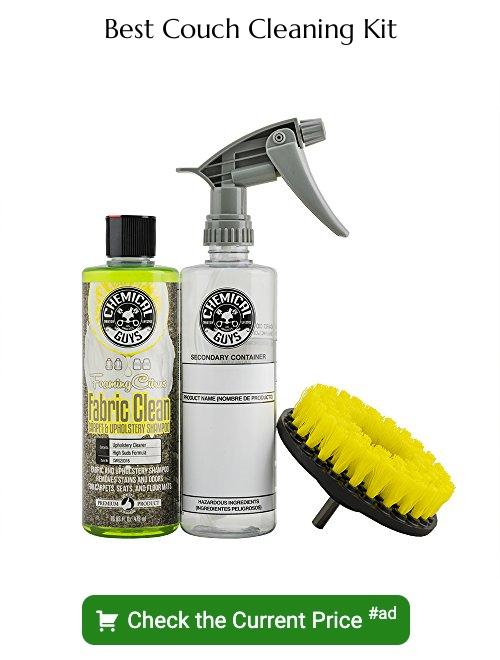Last updated on
Learn how to safely remove wax from your couch with these effective cleaning methods.
Key takeaways:
- Identify fabric type and cleaning code from manufacturer’s label.
- Allow wax to completely dry and solidify before removing.
- Carefully scrape off wax with a plastic card or butter knife.
- Use a warm iron and paper towels to transfer wax off the couch.
- Apply carpet cleaner or rubbing alcohol to remove any leftover residue.
Table of Contents
Assessing the Type of Fabric

Before attempting to remove wax from your couch, it’s crucial to determine the couch’s fabric type. This knowledge will dictate the most effective and safe cleaning method to use. There are typically two categories of upholstery: synthetic and natural fibers. Synthetic fibers, such as polyester and nylon, are generally more durable and can handle heat and certain chemicals better than natural fibers like cotton, silk or wool, which may require a gentler touch.
To identify the fabric, check the manufacturer’s label for the cleaning code. Codes like ‘W’ indicate that water-based cleaners are suitable, ‘S’ denotes a need for solvent-based cleaners, ‘SW’ means either type can be used, and ‘X’ means vacuum only, no water or solvent-based cleaners should be used. If the label is missing or unreadable, consider consulting a furniture professional before proceeding.
Knowing your couch’s fabric composition will ensure that the wax removal process does not inadvertently damage the upholstery. With this knowledge in hand, you can then move on to safely eliminating the wax.
Letting the Wax Dry Completely
Resist the temptation to immediately clean up spilled wax. A premature attempt can push the wax deeper into the fabric’s fibers, complicating the removal process. Letting the wax settle and solidify gives you a clear target for removal and typically prevents the stain from spreading.
In cooler environments, the wax will harden naturally. If you’re in a warmer setting or you need to hasten the process, place a bag of ice or a cold pack over the wax. This will expedite the hardening without introducing additional moisture. Monitor the wax, and once it’s brittle to the touch, you’re ready to move on to the next step. This patience paves the way for a more effective and less invasive removal technique.
Gently Scraping Off the Wax With a Plastic Card or Butter Knife
Once the wax is completely solidified, you can start the removal process with careful scraping. Opt for a plastic card, such as an old credit card, or a dull butter knife to avoid damaging the fabric. Approach this step with a light hand and patience—your goal is to lift off the wax, not the fiber of your couch.
Begin at the edges of the wax spill and work gently towards the center. This method helps to prevent spreading the wax further into the fabric. As you scrape, the wax should start to peel away in larger pieces, making subsequent cleaning stages more manageable. If the wax residue remains stubborn, resist the temptation to apply more force; this could embed the wax deeper or harm the upholstery. Keep the angle of the tool shallow to the surface and use smooth, consistent pressure for effective results.
Using a Warm Iron to Transfer Wax to Paper
Begin by placing a few layers of paper towels or an absorbent brown paper bag over the wax stain on your couch. Ensure the iron is on a low to medium setting without steam, as water can damage the couch fabric. Gently press the iron onto the paper, avoiding any direct contact with the fabric itself. The heat from the iron will melt the wax, allowing it to be absorbed into the paper.
Move the iron slowly over the paper, checking periodically to see if the wax is being lifted. Do not leave the iron in one place for too long as this can cause overheating of the fabric. As the paper absorbs the wax, reposition it to a clean area to avoid re-depositing wax onto the couch. Repeat the process as necessary until no more wax transfers onto the paper.
Once the majority of the wax has been lifted, some residue may remain. This can be treated with a suitable upholstery cleaner, depending on your couch’s fabric. Always perform a spot test in an inconspicuous area first.
Applying Carpet Cleaner or Rubbing Alcohol for Residual Wax
Once the bulk of the wax is lifted, you may still notice a light stain or waxy residue. This is where a carpet cleaner or rubbing alcohol comes into play; they act as solvents to break down the remaining wax.
For fabric upholstery, test the cleaner on an inconspicuous area first to ensure it doesn’t cause discoloration or damage. If the test is successful, lightly apply the cleaner onto the stained area using a clean, white cloth. Dab gently rather than rub to avoid pushing the wax deeper into the couch fabric.
Rubbing alcohol can be particularly effective for synthetic fabrics. Moisten a cotton ball with rubbing alcohol and gently blot the stained area. The alcohol will dissolve the residual wax, making it easier to lift from the fabric fibers.
Remember, patience is key — avoid the temptation to over-saturate the fabric, as too much liquid can further spread the wax or even damage the upholstery. Rinse the area with a cloth dipped in warm water and pat dry with a towel.
If dealing with leather upholstery, skip the water and use a leather cleaner instead to prevent water marks. Apply the leather cleaner according to the product’s instructions and then condition the leather to keep it supple after the treatment.
By following these steps, your couch should be free from wax without damage to its fabric. If you’re unsure about the type of fabric or the cleaning method, consult the manufacturer’s instructions or seek professional help.





